Flexible Wireless Passive LC Pressure Sensor with Design Methodology and Cost-Effective Preparation
Abstract
1. Introduction
2. Design, Fabrication, and Readout Principle of the LC Sensor
2.1. Design of the LC Sensor
2.2. Fabrication of the LC Sensor
2.3. Performance Test and the Readout Principle of the Copper Ring Device
3. Results and Discussion
3.1. Pressure Sensitivity Test of the Flexible LC Pressure Sensor
3.2. Flexible LC Pressure Sensing Array
3.3. Performance Tests of the Monopole Antenna for Reading the Flexible LC Pressure Sensor Information
3.4. Flexible LC Pressure Sensor for Monitoring Physical Motion Signals
4. Conclusions
Supplementary Materials
Author Contributions
Funding
Institutional Review Board Statement
Informed Consent Statement
Data Availability Statement
Acknowledgments
Conflicts of Interest
References
- Huang, X.; Liu, Y.; Cheng, H.; Shin, W.J.; Fan, J.A.; Liu, Z.; Lu, C.J.; Kong, G.W.; Chen, K.; Patnaik, D.; et al. Materials and designs for wireless epidermal sensors of hydration and strain. Adv. Funct. Mater. 2014, 24, 3846–3854. [Google Scholar] [CrossRef]
- Kang, S.; Lee, J.; Lee, S.; Kim, S.; Kim, J.-K.; Algadi, H.; Al-Sayari, S.; Kim, D.-E.; Lee, T. Highly Sensitive Pressure Sensor Based on Bioinspired Porous Structure for Real-Time Tactile Sensing. Adv. Electron. Mater. 2016, 2, 1600356. [Google Scholar] [CrossRef]
- Ma, L.; Yu, X.; Yang, Y.; Hu, Y.; Zhang, X.; Li, H.; Ouyang, X.; Zhu, P.; Sun, R.; Wong, C.-P. Highly sensitive flexible capacitive pressure sensor with a broad linear response range and finite element analysis of micro-array electrode. J. Mater. 2019, 6, 321–329. [Google Scholar] [CrossRef]
- Zhao, S.; Ran, W.; Wang, D.; Yin, R.; Yan, Y.; Jiang, K.; Lou, Z.; Shen, G. 3D Dielectric Layer Enabled Highly Sensitive Capacitive Pressure Sensors for Wearable Electronics. ACS Appl. Mater. Interfaces 2020, 12, 32023–32030. [Google Scholar] [CrossRef]
- Wan, Y.; Qiu, Z.; Hong, Y.; Wang, Y.; Zhang, J.; Liu, Q.; Wu, Z.; Guo, C.F. A Highly Sensitive Flexible Capacitive Tactile Sensor with Sparse and High-Aspect-Ratio Microstructures. Adv. Electron. Mater. 2018, 4, 1700586. [Google Scholar] [CrossRef]
- Yang, J.; Mun, J.; Kwon, S.; Park, S.; Bao, Z.; Park, S. Electronic Skin: Recent Progress and Future Prospects for Skin-Attachable Devices for Health Monitoring, Robotics, and Prosthetics. Adv. Mater. 2019, 31, 1904765. [Google Scholar] [CrossRef] [PubMed]
- Mehmood, N.; Hariz, A.; Templeton, S.; Voelcker, N.H. An Improved Flexible Telemetry System to Autonomously Monitor Sub-Bandage Pressure and Wound Moisture. Sensors 2014, 14, 21770–21790. [Google Scholar] [CrossRef]
- Farooqui, M.F.; Shamim, A. Low Cost Inkjet Printed Smart Bandage for Wireless Monitoring of Chronic Wounds. Sci. Rep. 2016, 6, 28949. [Google Scholar] [CrossRef] [PubMed]
- Huang, Q.-A.; Dong, L.; Wang, L.-F. LC Passive Wireless Sensors toward a Wireless Sensing Platform: Status, Prospects, and Challenges. J. Microelectromechanical Syst. 2016, 25, 822–841. [Google Scholar] [CrossRef]
- Kim, J.; Gutruf, P.; Chiarelli, A.M.; Heo, S.Y.; Cho, K.; Xie, Z.; Banks, A.; Han, S.; Jang, K.I.; Lee, J.W.; et al. Miniaturized battery-free wireless systems for wearable pulse oximetry. Adv. Funct. Mater. 2017, 27, 1604373. [Google Scholar] [CrossRef]
- Jeong, H.; Wang, L.; Ha, T.; Mitbander, R.; Yang, X.; Dai, Z.; Qiao, S.; Shen, L.; Sun, N.; Lu, N. Modular and Reconfigurable Wireless E-Tattoos for Personalized Sensing. Adv. Mater. Technol. 2019, 4, 1900117. [Google Scholar] [CrossRef]
- Kim, J.; Campbell, A.S.; de Ávila, B.E.; Wang, J. Wearable biosensors for healthcare monitoring. Nat. Biotechnol. 2019, 37, 389–406. [Google Scholar] [CrossRef] [PubMed]
- Gutruf, P.; Krishnamurthi, V.; Vázquez-Guardado, A.; Xie, Z.; Banks, A.; Su, C.-J.; Xu, Y.; Haney, C.R.; Waters, E.A.; Kandela, I.; et al. Fully implantable optoelectronic systems for battery-free, multimodal operation in neuroscience research. Nat. Electron. 2018, 1, 652–660. [Google Scholar] [CrossRef]
- Han, S.; Kim, J.; Won, S.M.; Ma, Y.; Kang, D.; Xie, Z.; Lee, K.-T.; Chung, H.U.; Banks, A.; Min, S.; et al. Battery-free, wireless sensors for full-body pressure and temperature mapping. Sci. Transl. Med. 2018, 10, eaan4950. [Google Scholar] [CrossRef] [PubMed]
- Heo, S.Y.; Kim, J.; Gutruf, P.; Banks, A.; Wei, P.; Pielak, R.; Balooch, G.; Shi, Y.; Araki, H.; Rollo, D.; et al. Wireless, battery-free, flexible, miniaturized dosimeters monitor exposure to solar radiation and to light for phototherapy. Sci. Transl. Med. 2018, 10, eaau1643. [Google Scholar] [CrossRef]
- Chen, L.Y.; Tee, C.K.; Chortos, A.; Schwartz, G.; Tse, V.; Lipomi, D.J.; Wong, H.-S.P.; McConnell, M.; Bao, Z. Continuous wireless pressure monitoring and mapping with ultra-small passive sensors for health monitoring and critical care. Nat. Commun. 2014, 5, 5028. [Google Scholar] [CrossRef] [PubMed]
- Kou, H.; Zhang, L.; Tan, Q.; Liu, G.; Dong, H.; Zhang, W.; Xiong, J. Wireless wide-range pressure sensor based on graphene/PDMS sponge for tactile monitoring. Sci. Rep. 2019, 9, 3916. [Google Scholar] [CrossRef]
- Deng, W.-J.; Wang, L.-F.; Dong, L.; Huang, Q.-A. LC Wireless Sensitive Pressure Sensors with Microstructured PDMS Dielectric Layers for Wound Monitoring. IEEE Sens. J. 2018, 18, 4886–4892. [Google Scholar] [CrossRef]
- Nie, B.; Huang, R.; Yao, T.; Zhang, Y.; Miao, Y.; Liu, C.; Liu, J.; Chen, X. Textile-Based Wireless Pressure Sensor Array for Human-Interactive Sensing. Adv. Funct. Mater. 2019, 29, 1808786. [Google Scholar] [CrossRef]
- Deng, W.-J.; Wang, L.-F.; Dong, L.; Huang, Q.-A. Symmetric LC Circuit Configurations for Passive Wireless Multifunctional Sensors. J. Microelectromechanical Syst. 2019, 28, 344–350. [Google Scholar] [CrossRef]
- Lee, G.H.; Park, J.K.; Byun, J.; Yang, J.C.; Kwon, S.Y.; Kim, C.; Jang, C.; Sim, J.Y.; Yook, J.G.; Park, S. Parallel signal processing of a wireless pressure-sensing platform combined with machine-learning-based cognition, inspired by the human somatosensory system. Adv. Mater. 2020, 32, 1906269. [Google Scholar] [CrossRef] [PubMed]
- Zhai, Y.; Lee, J.; Hoang, Q.; Sievenpiper, D.; Garudadri, H.; Ng, T.-N. Printed wireless fluidic pressure sensor. Flex. Print. Electron. 2018, 3, 035006. [Google Scholar] [CrossRef]
- Lu, D.; Yan, Y.; Deng, Y.; Yang, Q.; Zhao, J.; Seo, M.; Bai, W.; MacEwan, M.R.; Huang, Y.; Ray, W.Z.; et al. Bioresorbable Wireless Sensors as Temporary Implants for In Vivo Measurements of Pressure. Adv. Funct. Mater. 2020, 30, 2003754. [Google Scholar] [CrossRef]
- Palmroth, A.; Salpavaara, T.; Lekkala, J.; Kellomäki, M. Fabrication and Characterization of a Wireless Bioresorbable Pressure Sensor. Adv. Mater. Technol. 2019, 4, 1900428. [Google Scholar] [CrossRef]
- Zolog, M.; Pitica, D.; Pop, O. Characterization of Spiral Planar Inductors Built on Printed Circuit Boards. In 2007 30th International Spring Seminar on Electronics Technology (ISSE); IEEE: Piscataway, NJ, USA, 2007; pp. 308–313. [Google Scholar] [CrossRef]
- Huang, Y.; Wang, Y.; Xiao, L.; Liu, H.; Dong, W.; Yin, Z. Microfluidic serpentine antennas with designed mechanical tunability. Lab Chip 2014, 14, 4205–4212. [Google Scholar] [CrossRef]
- Wang, C.; Yeo, J.C.; Chu, H.; Lim, C.T.; Guo, Y.-X. Design of a Reconfigurable Patch Antenna Using the Movement of Liquid Metal. IEEE Antennas Wirel. Propag. Lett. 2018, 17, 974–977. [Google Scholar] [CrossRef]
- Nopper, R.; Niekrawietz, R.; Reindl, L. Wireless Readout of Passive LC Sensors. IEEE Trans. Instrum. Meas. 2009, 59, 2450–2457. [Google Scholar] [CrossRef]
- Farooq, M.; Iqbal, T.; Vazquez, P.; Farid, N.; Thampi, S.; Wijns, W.; Shahzad, A. Thin-Film Flexible Wireless Pressure Sensor for Continuous Pressure Monitoring in Medical Applications. Sensors 2020, 20, 6653. [Google Scholar] [CrossRef] [PubMed]
- Zhang, L.-N.; Zhong, S.-S.; Liang, X.-L.; Li, C.-H. Compact meander monopole antenna for tri-band WLAN application. Microw. Opt. Technol. Lett. 2007, 49, 986–988. [Google Scholar] [CrossRef]
- Zhao, G.; Zhang, F.-S.; Weng, Z.-B.; Jiao, Y.-C. Compact ring monopole antenna with double meander lines for 2.4/5 GHZ dual-band operation, Progress in Electromagnetics Research-pier. Prog. Electromagn. Res. 2007, 72, 187–194. [Google Scholar] [CrossRef][Green Version]
- Liu, H.-W.; Ku, C.-H.; Yang, C.-F. Novel cpw-fed planar monopole antenna for WLAN/WiMAX applications, Antennas and Wireless Propagation Letters. IEEE Antennas Wirel. Propag. Lett. 2010, 9, 240–243. [Google Scholar] [CrossRef]
- Lu, F.; Tan, Q.; Ji, Y.; Guo, Q.; Guo, Y.; Xiong, J. A Novel Metamaterial Inspired High-Temperature Microwave Sensor in Harsh Environments. Sensors 2018, 18, 2879. [Google Scholar] [CrossRef] [PubMed]
- Kou, H.; Tan, Q.; Wang, Y.; Zhang, G.; Su, S.; Xiong, J. A microwave SIW sensor loaded with CSRR for wireless pressure detection in high-temperature environments. J. Phys. D Appl. Phys. 2019, 53, 085101. [Google Scholar] [CrossRef]

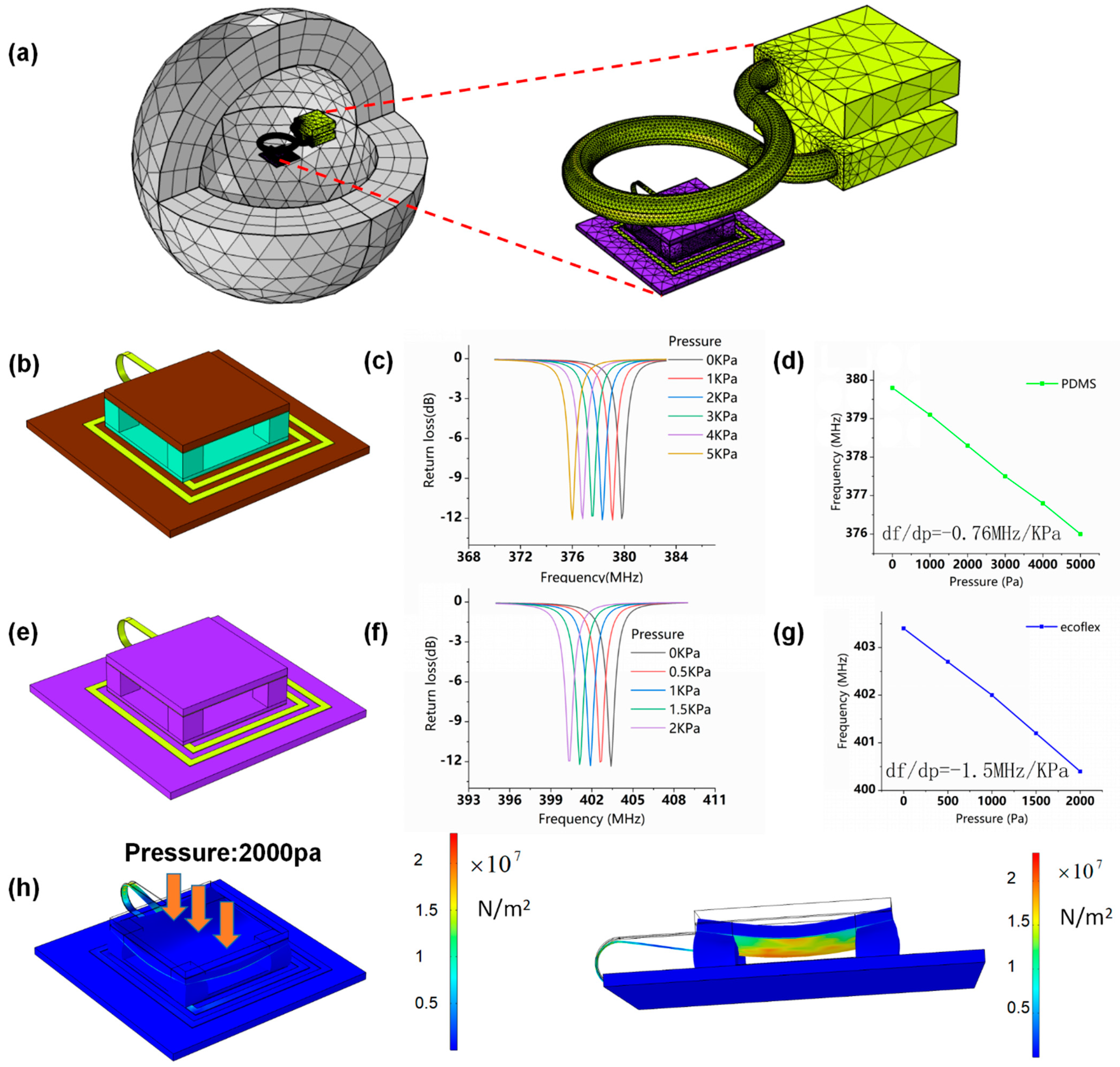
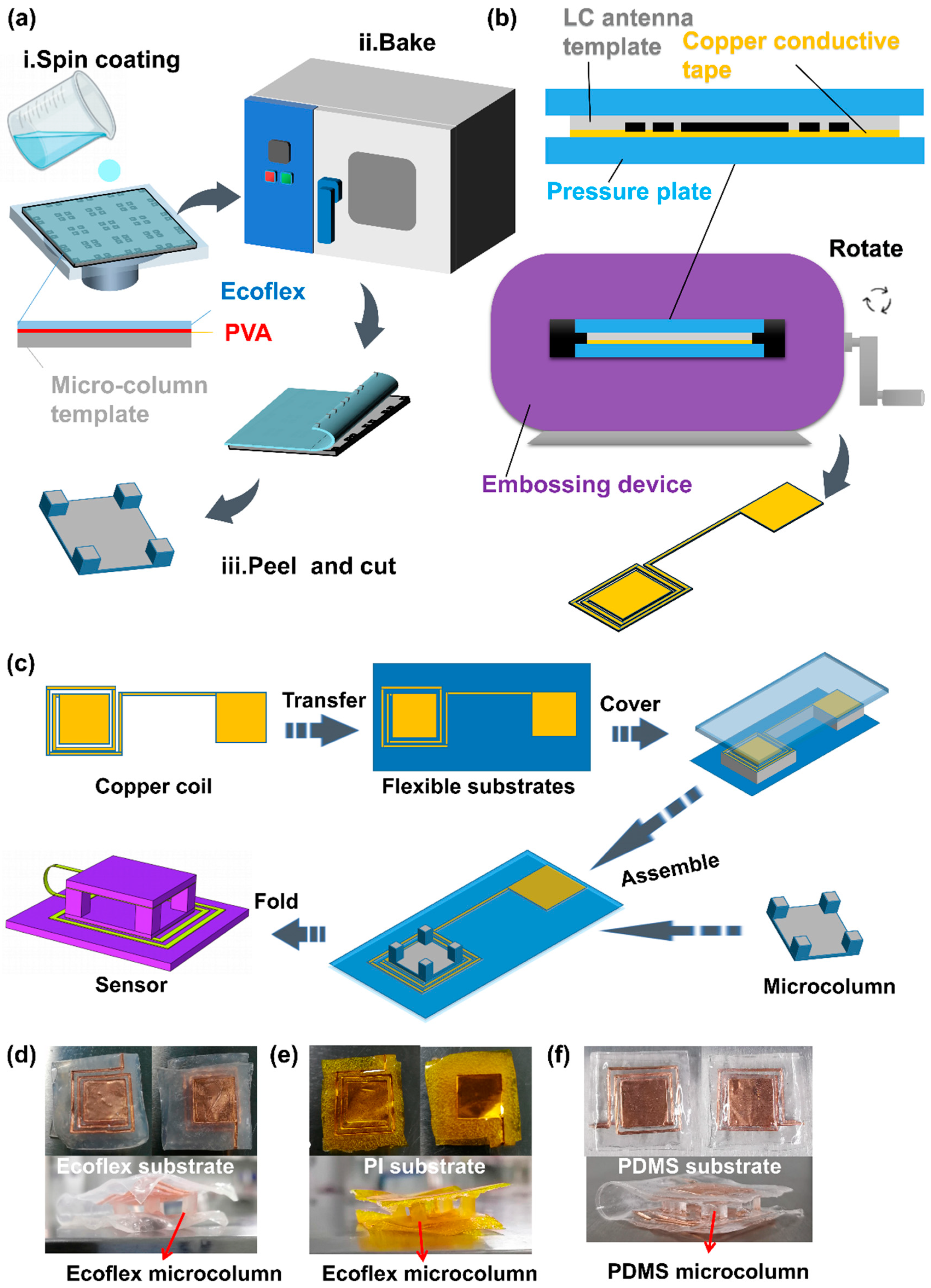
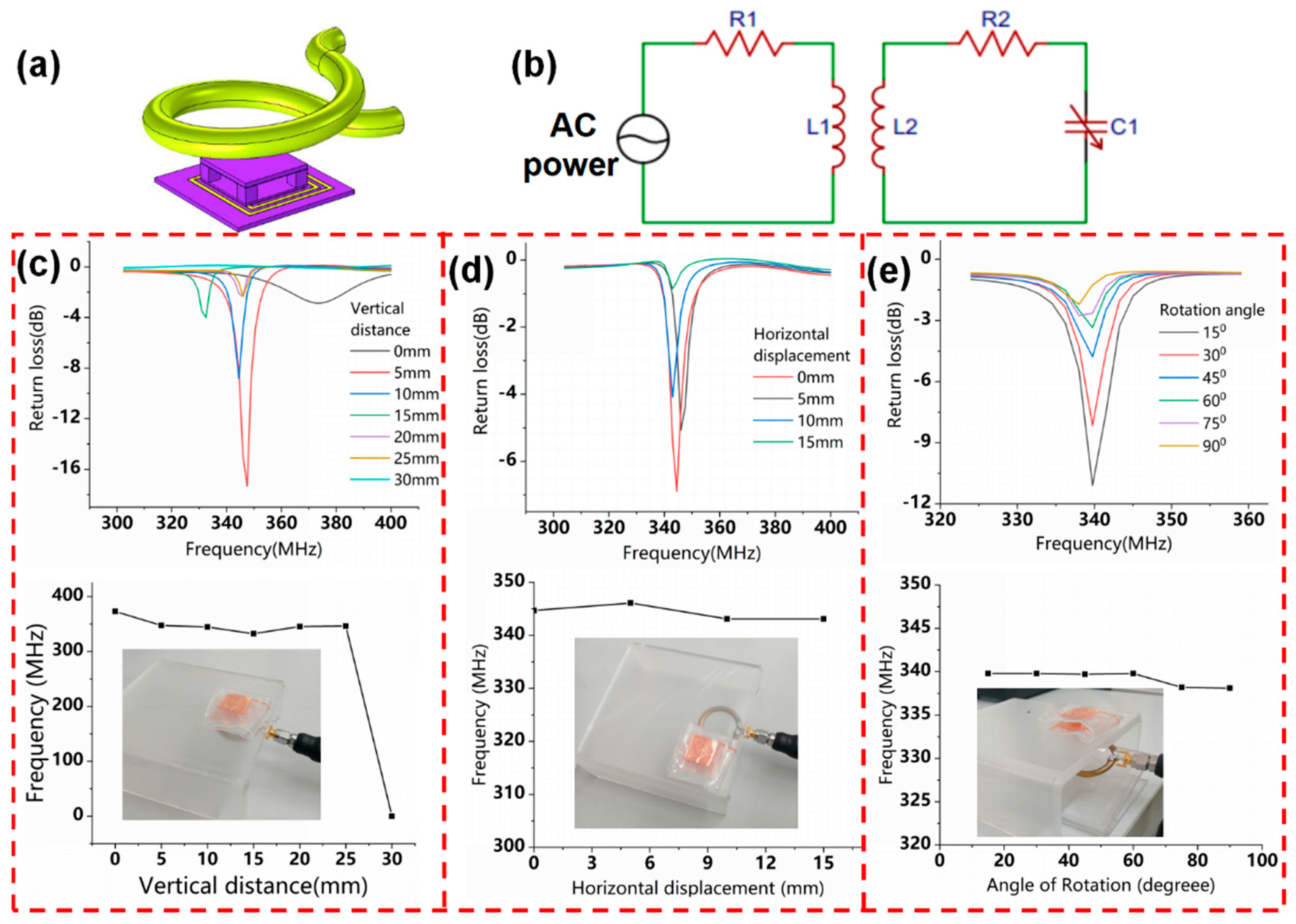
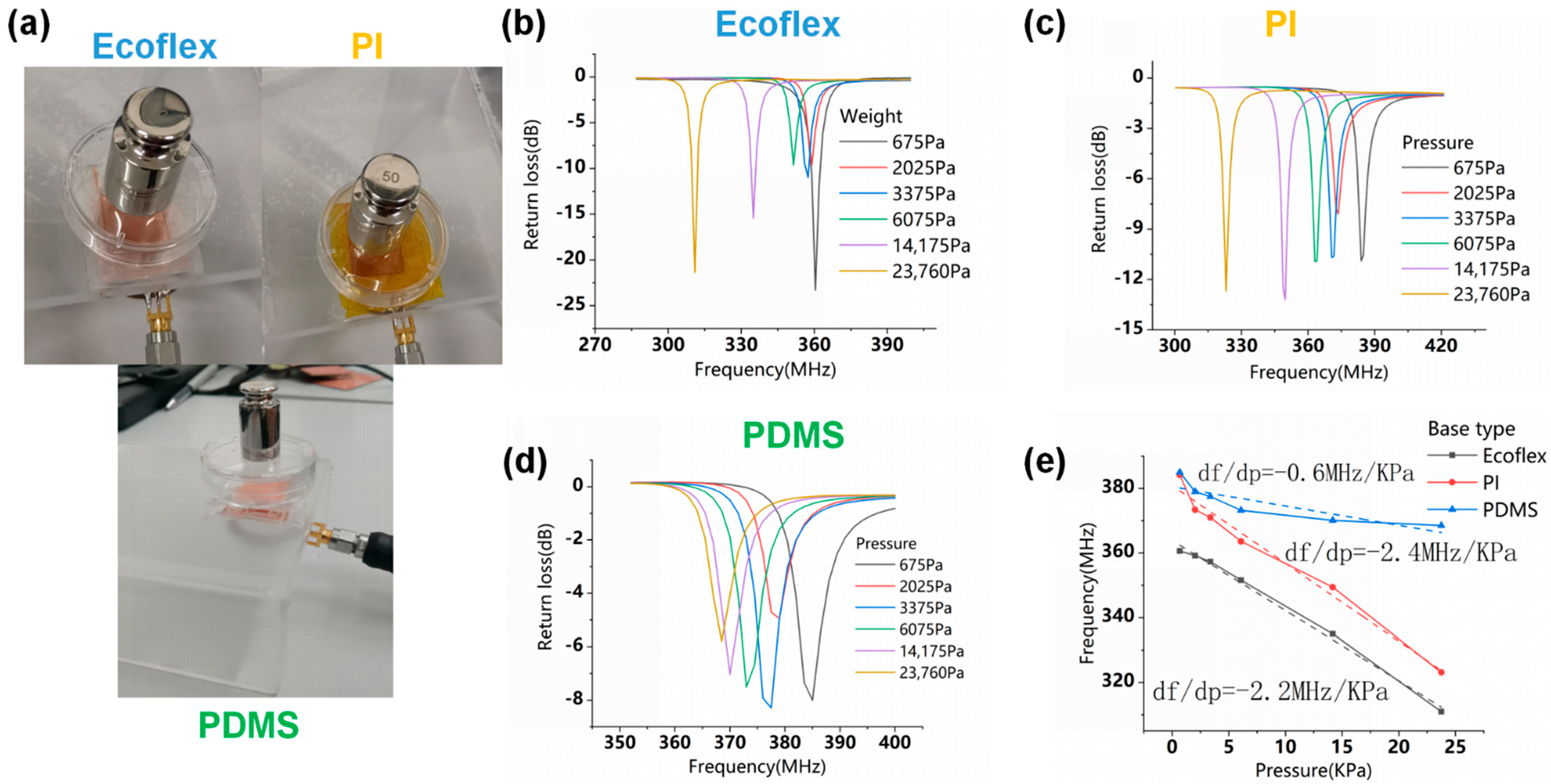
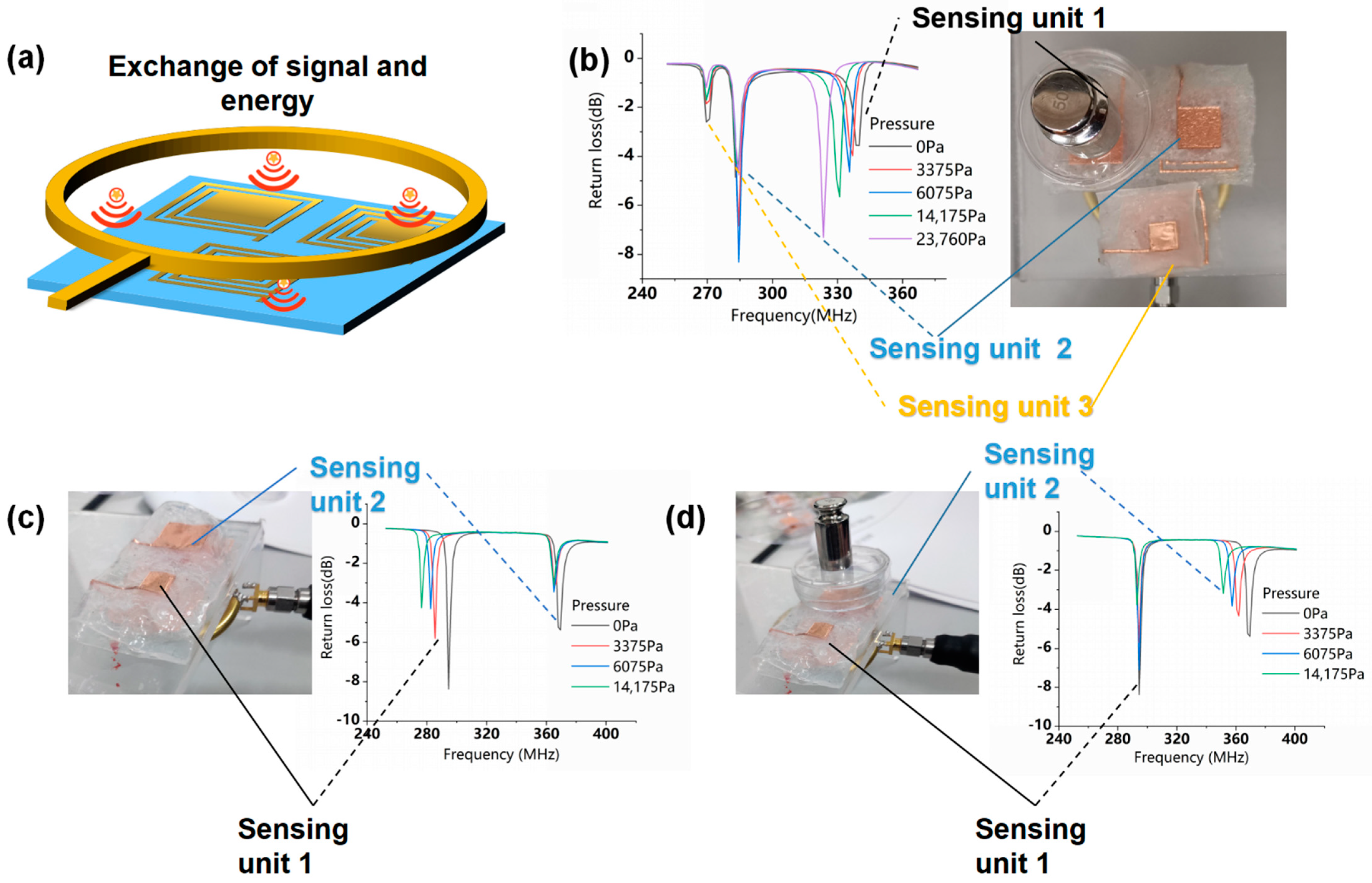

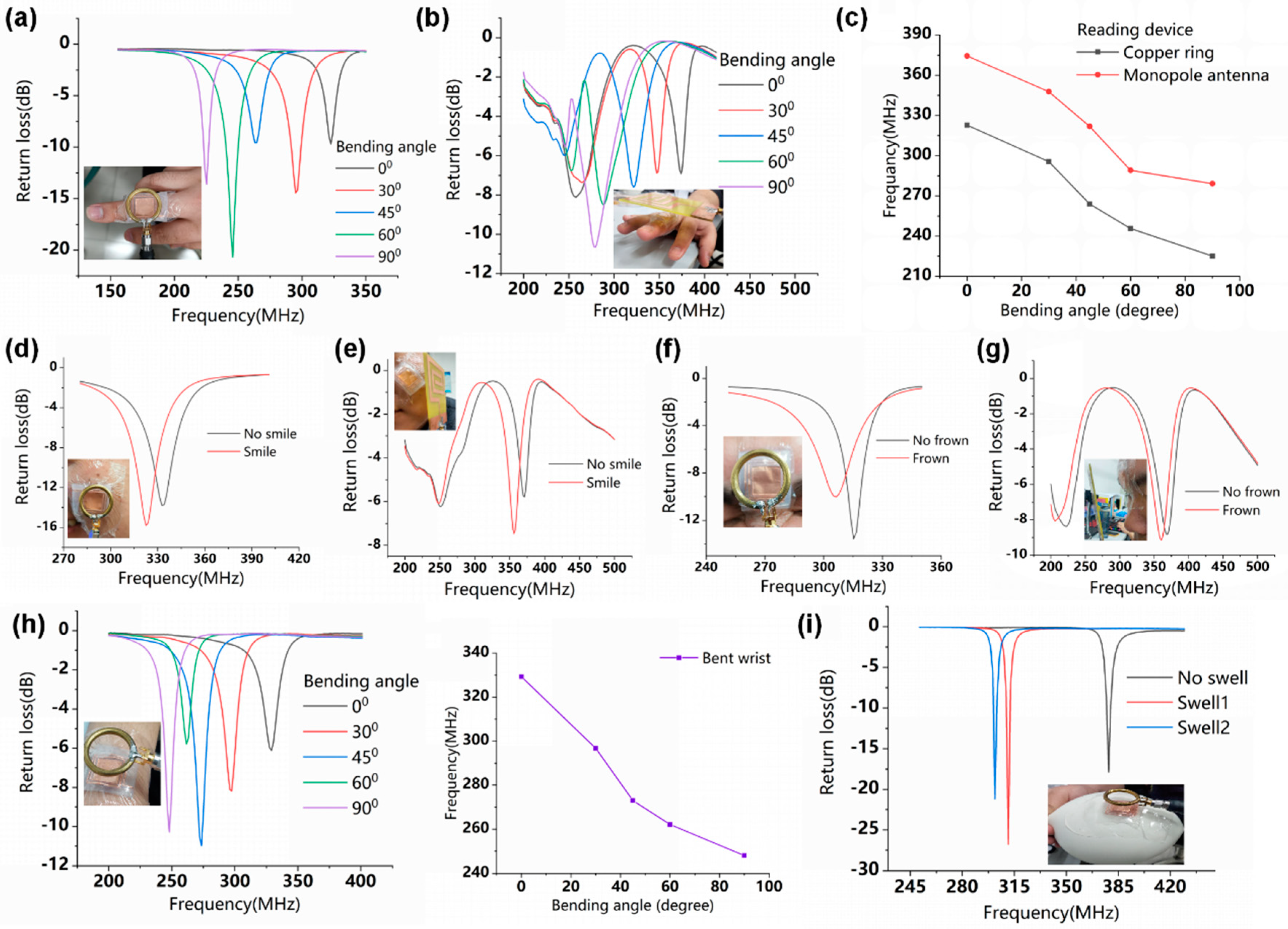
| Flexible LC Pressure Sensors | Pressure Sensitivity (Experimental Results) | Pressure Sensitivity (Finite Element Simulation) |
|---|---|---|
| The sensor based on Ecoflex material | −2.2 MHz/kPa | −1.5 MHz/kPa |
| The sensor based on PDMS material | −0.6 MHz/kPa | −0.76 MHz/kPa |
| The sensor based on thin PI substrate and Ecoflex micro-column dielectric | −2.4 MHz/kPa |
| Sensor | Sensitivity | Sensor | Sensitivity |
|---|---|---|---|
| Sensor in this paper | −2.2 MHz/kPa | Piezo Inkjet printing LC pressure sensor [22] | −0.083 MHz/kPa |
| Ultra-small flexible LC pressure sensor [16] | −10.7 MHz/kPa | Bioabsorbable wireless pressure sensor [23] | −1.5 MHz/kPa |
| LC pressure sensor based on textile [19] | −0.19 MHz/kPa | Wireless bioabsorbable pressure sensor embedded in orthopedic implants [24] | −0.045 MHz/kPa |
| LC pressure sensor for wound monitoring [18] | −2.2 MHz/kPa | Dual-parameter LC pressure sensor simultaneously monitors pressure and humidity [20] | −0.36 MHz/kPa |
| LC pressure sensor based on graphene/PDMS sponge [17] | −2.2 MHz/kPa | Thin film flexible LC pressure sensor [29] | −0.49 MHz/kPa |
| Readout Device | Vertical Distance | Horizontal Displacement | Rotation Angle |
|---|---|---|---|
| Planar monopole antenna | 4 cm | 8 cm | |
| Copper ring | 2.5 cm | 1.5 cm |
Publisher’s Note: MDPI stays neutral with regard to jurisdictional claims in published maps and institutional affiliations. |
© 2021 by the authors. Licensee MDPI, Basel, Switzerland. This article is an open access article distributed under the terms and conditions of the Creative Commons Attribution (CC BY) license (https://creativecommons.org/licenses/by/4.0/).
Share and Cite
Sun, Z.; Fang, H.; Xu, B.; Yang, L.; Niu, H.; Wang, H.; Chen, D.; Liu, Y.; Wang, Z.; Wang, Y.; et al. Flexible Wireless Passive LC Pressure Sensor with Design Methodology and Cost-Effective Preparation. Micromachines 2021, 12, 976. https://doi.org/10.3390/mi12080976
Sun Z, Fang H, Xu B, Yang L, Niu H, Wang H, Chen D, Liu Y, Wang Z, Wang Y, et al. Flexible Wireless Passive LC Pressure Sensor with Design Methodology and Cost-Effective Preparation. Micromachines. 2021; 12(8):976. https://doi.org/10.3390/mi12080976
Chicago/Turabian StyleSun, Zhuqi, Haoyu Fang, Baochun Xu, Lina Yang, Haoran Niu, Hongfei Wang, Da Chen, Yijian Liu, Zhuopeng Wang, Yanyan Wang, and et al. 2021. "Flexible Wireless Passive LC Pressure Sensor with Design Methodology and Cost-Effective Preparation" Micromachines 12, no. 8: 976. https://doi.org/10.3390/mi12080976
APA StyleSun, Z., Fang, H., Xu, B., Yang, L., Niu, H., Wang, H., Chen, D., Liu, Y., Wang, Z., Wang, Y., & Guo, Q. (2021). Flexible Wireless Passive LC Pressure Sensor with Design Methodology and Cost-Effective Preparation. Micromachines, 12(8), 976. https://doi.org/10.3390/mi12080976





